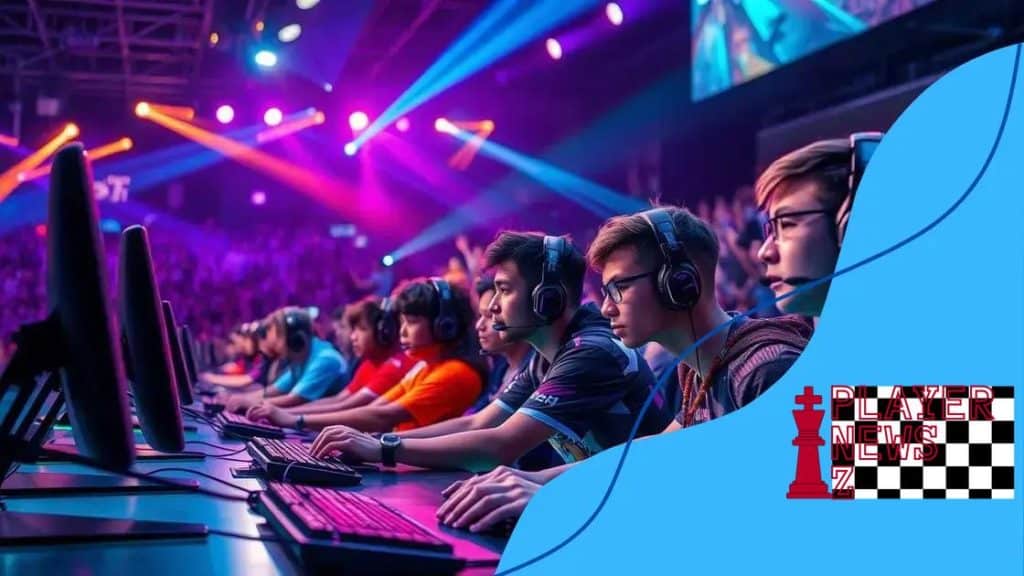Online e-sports leagues and their global reach

Online e-sports leagues engage global audiences through accessible platforms, immersive experiences like virtual reality, and a strong emphasis on community building, reshaping the future of competitive gaming.
Online e-sports leagues have taken the world by storm, captivating millions and reshaping how we view competition and community. Are you curious about how these leagues expand their reach across the globe?
Understanding the rise of online e-sports leagues
The world of online e-sports leagues has seen explosive growth in recent years. As more players and fans engage with these competitions, it’s essential to understand what drives this rise. E-sports leagues have become more accessible thanks to technology and the internet, allowing players worldwide to compete and showcase their skills on a global stage.
Factors Contributing to Growth
Several aspects contribute to the popularity of online e-sports leagues:
- Increased Accessibility: With platforms like Twitch and YouTube, players can easily find and join leagues from the comfort of their homes.
- Community Engagement: E-sports leagues foster vibrant communities where fans can interact, share strategies, and cheer for their favorite teams.
- Sponsorship and Investment: Major brands are recognizing the potential of e-sports, leading to significant sponsorship deals that elevate the professionalism of leagues.
- Technological Advancements: Improved streaming technology ensures high-quality broadcasts, allowing fans to enjoy games in real time.
Furthermore, the rise of mobile gaming has expanded the reach of e-sports leagues. Players no longer need expensive gaming setups; they can compete using their smartphones. This accessibility opens the door for millions of new players and fans, leading to more diverse competition and a broader audience. Moreover, educational institutions are beginning to recognize e-sports as a viable career path, encouraging students to participate in online leagues.
The Impact of Social Media
Social media has also played a crucial role in popularizing online e-sports leagues. Platforms like Twitter, Instagram, and TikTok allow players and teams to connect with fans and share moments instantly. This real-time interaction keeps fans engaged between matches, creating a continuous buzz around the leagues.
As e-sports continue to break down barriers and evolve, they are shaping the future of competitive gaming. Understanding this growth provides insights into how industries could pivot towards integrating gaming and traditional sports in the coming years.
Key players in the global e-sports industry
The global e-sports industry is shaped by several key players, including game developers, teams, and tournament organizers. Understanding their roles helps highlight how e-sports has evolved into a professional and competitive field.
Major Game Developers
Game developers are at the heart of the e-sports ecosystem. They create titles that engage players worldwide. Some of the leading developers include:
- Riot Games: Known for titles like League of Legends, they host major tournaments with significant prize pools.
- Activision Blizzard: With games like Overwatch and Call of Duty, they contribute to the competitive gaming landscape.
- Valve Corporation: Developers of Dota 2 and Counter-Strike: Global Offensive, they have a strong presence in the e-sports scene.
- Epic Games: They revolutionized gaming with Fortnite, attracting millions of players and spectators.
These developers invest in creating an engaging experience. They support the community through regular updates, events, and sponsorships, establishing a sense of loyalty and excitement among players.
Professional Teams
Another vital part of the e-sports ecosystem consists of professional teams. These teams recruit talented players and compete on various platforms. For example, teams like Team Liquid and FaZe Clan have garnered huge fan bases and sponsorships.
In addition to competitive success, these teams help amplify the reach of the e-sports industry. They create fan engagement strategies through social media, which keeps audiences connected and informed about events and tournaments.
Tournament Organizers
Tournament organizers play a crucial role in facilitating competitions. They coordinate events and ensure fair play in tournaments. Major organizers include ESL and DreamHack, hosting significant events around the globe.
By creating large-scale events, they draw in crowds both online and offline. This fosters not only competition but a sense of community among players and fans. They often partner with sponsors to provide better experiences and larger prize pools.
Overall, the synergy among these key players shapes the global e-sports industry, making it a dynamic and rapidly growing field.
Impact of e-sports on traditional sports markets

The impact of e-sports on traditional sports markets is becoming increasingly evident. As e-sports gain popularity, traditional sports organizations are taking notice and adapting to this new landscape. This has led to various changes in how sports are marketed and consumed.
Cross-Promotion Opportunities
Many traditional sports leagues are starting to integrate e-sports into their events, recognizing the potential for cross-promotion. For instance, leagues like the NBA have introduced NBA 2K tournaments, allowing fans to engage with their favorite teams in a new way. By hosting these events, they attract younger audiences who may not usually watch traditional sports.
- Engagement with Younger Audiences: E-sports reach demographics that many traditional sports struggle to engage, particularly younger generations.
- Increased Sponsorship Deals: Companies are more willing to invest in e-sports as they see the potential audiences that overlap with traditional sports fans.
- Collaborative Events: Events that combine traditional sports with e-sports have gained popularity, allowing a wider array of content for fans.
As a result, traditional sports leagues are exploring partnerships with e-sports organizations to benefit from this trend. This collaboration can lead to expanding both markets, bringing in new fans and improving revenue streams.
Changing Fan Experiences
The way fans experience sports is also changing. E-sports offer interactive elements that traditional sports are now trying to adopt. Fans can participate in live streaming, engage in online communities, and even affect gameplay through voting or decisions in games.
This level of interaction can enhance the viewing experience, making it more engaging compared to traditional sports broadcasts. Additionally, e-sports events often utilize innovative technology to deliver immersive experiences to fans, which can inspire traditional sports to explore similar advancements.
The relationship between e-sports and traditional sports markets continues to evolve as both recognize the value in each other. As this trend progresses, we may see more collaborative efforts that further bridge the gap between these two worlds.
How online leagues engage international audiences
Online leagues are transforming the way fans engage with e-sports on a global scale. This new format allows players from different countries to compete while inviting audiences from various backgrounds to join in the excitement.
Global Accessibility
One of the main reasons online leagues successfully engage international audiences is their accessibility. Anyone can participate or watch matches from anywhere in the world, providing a unique way for fans to enjoy competitive gaming.
- Live Streaming: Platforms like Twitch and YouTube Gaming enable fans to watch matches live, no matter their location.
- Language Options: Many streams offer commentary in multiple languages, catering to a broader demographic.
- Time Zone Considerations: Leagues often schedule matches at varying times to accommodate different time zones.
This accessibility fosters a growing fan base who can connect over shared interests, regardless of where they live. They can follow teams and players, making the experience feel more personal.
Community Building
Online leagues also promote community engagement, allowing fans to interact not only with the players but also among themselves. Social media platforms create spaces for discussions, sharing highlights, and celebrating victories together.
Players often stream their matches while engaging with their chat, creating a strong sense of community. This direct interaction allows fans to feel a part of the action, enhancing their experience. Many leagues also create forums or Discord servers where fans can discuss strategies and share content.
Regional Tournaments
In addition to global leagues, regional tournaments have emerged, catering to local audiences. These events help fans connect on a more personal level, as they support teams from their own countries. This can create national pride and boost local engagement.
As online leagues continue to grow, they will likely explore new ways to engage audiences further. The combination of accessibility, community, and regional focus allows e-sports to flourish on a global level, attracting diverse audiences with shared passions.
Future trends in e-sports and their global influence
The future trends in e-sports promise to revolutionize the gaming landscape even further. As technology evolves and player engagement increases, several key areas are emerging that are likely to influence the global e-sports scene.
Increased Use of Virtual Reality
Virtual reality (VR) is expected to play a significant role in the growth of e-sports. With VR technology becoming more affordable and accessible, game developers are integrating it into competitive gaming. This shift offers players a more immersive experience and allows for innovative gameplay mechanics that could change how games are played during tournaments.
- Immersive Experiences: VR can enhance the way players and audiences experience e-sports.
- New Game Genres: The rise of VR may lead to the development of entirely new genres of competitive games.
- Interactive Audience Features: Fans may participate in a more interactive way during matches, such as feeling like they are actually in the game.
This technology not only attracts traditional gamers but also draws in new audiences curious about the possibilities of VR.
Growth of Mobile E-sports
Mobile gaming has been on the rise, and its impact on e-sports cannot be overlooked. Games like PUBG Mobile and Clash Royale have gained a massive following, turning casual players into competitive ones. Esports events centered around mobile games are becoming more common, showcasing the skills of top players on this platform.
The accessibility of mobile devices means that aspiring players can participate in leagues without needing expensive gaming rigs. It opens the door to a new generation of gamers who prefer playing on their phones.
Enhanced Global Sponsorships
As e-sports grow, sponsorship opportunities will expand, leading to increased investments in the industry. Companies from various sectors, including tech, energy drinks, and fashion, are beginning to see the value in partnering with e-sports leagues and organizations.
These partnerships can amplify brand visibility, tapping into a young and engaged audience that traditional marketing might miss. Sponsorships can provide better production value for events and help attract top-tier talent, creating a more exciting atmosphere for both players and fans.
In summary, the future of e-sports is bright with trends like virtual reality integration, the growth of mobile gaming, and enhanced global sponsorships shaping its landscape. These changes promise to not only engage existing fans but also attract new audiences, further solidifying e-sports’ place as a major force in the entertainment industry.
FAQ – Frequently Asked Questions about E-sports and Their Global Influence
What are the main factors driving the growth of e-sports?
Key factors include increased accessibility through online platforms and mobile gaming, as well as growing sponsorship opportunities.
How are traditional sports integrating e-sports?
Many traditional sports leagues are hosting e-sports tournaments and collaborating with game developers to reach younger audiences.
What role does virtual reality play in the future of e-sports?
Virtual reality enhances the gaming experience, making it more immersive and interactive, which could attract more players and fans.
How can fans engage with e-sports events?
Fans can watch live streams, participate in online communities, and interact directly with players during matches through platforms like Twitch.





